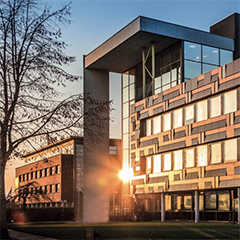Since our jump into the façade market, we’ve encountered multiple technology-combinations on façades, which make a lot of sense and left us scratching our heads, thinking, why hasn’t this been done before? The answer turns out to be deceptively simple: PV hasn’t really been a building element until now. Seeing other companies use our products for smarter solutions, we have also investigated whether we can make our production process smarter to accommodate these many applications.
Lighting and data communication
Solarix Helmond was launched in December and marked the first combination of colored PV, LED lighting and data communication on the façade. Studio Solarix, the brains behind this façade, designed Solarix Helmond to communicate with its surroundings, visualize incoming data, and to generate sustainable energy without sacrificing aesthetics. The façade was fitted with multiple features to accomplish this.
Sorba Projects manufactured the Alpolic backing, a folded aluminum/composite element that gives the façade its robustness and mechanical fixing to the rear construction. The folded element was designed together with Studio Solarix to hold the PV modules and hide LED lighting and cabling, whilst also remaining modular in its implementation. With a hook-type fixing, the elements can be easily detached for possible maintenance yet virtually impossible to be blown off during a storm.
Kameleon Solar manufactured the PV modules in color using our ColorBlast™ technique. With ceramic printing and scanning equipment we are able to match and re-create colors desired by architects and designers. Studio Solarix had designed 9 types of modules for the façade, three sizes each to be made in three colors. The sizes made the internal design of the modules challenging, as an uneven amount of strings were used, and the junction box needed to be placed centrally.
Kuijpers Installatie used their preferred brand of inverters to connect the PV. The largest challenge they faced during this project was the cabling of the LED lighting, which came to nearly 5km, which needed to be hidden behind the façade elements in cable ducts. The LED was installed so that programs could be run (semi-) automatically.
The lights were programmed to music for the opening, sometimes acting like the keys on a piano, sometimes mimicking volumes or soundwaves. Later, the façade can be used to communicate the amount of energy generated, or as a barometer, to alert the locals when rain is on the way.




























